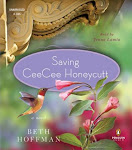 A long way gone: memoirs of a boy soldier
A long way gone: memoirs of a boy soldier / Ishmael Beah. – [New York] : Audio Renaissance, 2007.
7 sound discs (8 hr., 30 min.) : digital ; 4 3/4 in.
Unabridged
Read by the author
Compact discs
ISBN: 9781427202307
1. Beah, Ishmael, 1980- 2. Child soldiers -- Sierra Leone – Biography. 3. Sierra Leone -- History -- Civil War, 1991-2002 -- Participation, Juvenile – Biography. 4. Sierra Leone -- History -- Civil War, 1991-2002 -- Personal narratives. 5. Sierra Leone -- Social conditions -- 1961-
966.404
The West African nation of Sierra Leone was torn by civil war from 1991 to 2002. The country is still struggling to overcome the effects of this eleven-year conflict. This is the memoir of one of the participants. Beah remembers the war coming to his home when he was about twelve. When rebel soldiers attacked his village, he and his brother were separated from the rest of their family and began wandering through the jungle with some other boys trying to survive and stay away from the fighting. Captured and terrorized by rebel soldiers or by villagers who thought they might be spies or soldiers they escaped again and again. During one of these escapes Ishmael was separated from his brother, and then fell in with another group of boys. Eventually they came to a village protected by government soldiers.
When the rebels began to close in on the village the army impressed all the male villagers including the boys. They were given army shorts, t-shirts, and green headbands for uniforms and AK-47s. They were taught how to creep though the jungle, how to use and care for their automatic rifles, how to fire rocket propelled grenades, and how to use their bayonets. As Beah remembers it, “over and over in our training [the corporal] would say that same sentence: Visualize the enemy, the rebels who killed your parents, your family, and those who are responsible for everything that has happened to you.” [The emphasis is in the original text.] Vivid images of revenge where reinforced by readily available marijuana, cocaine, “brown-brown” (cocaine mixed with gunpowder) and “white capsules” that Beah remembers having kept him awake for days on end. Thus boys aged ten and up were turned into brutally efficient soldiers who visited on rebel villages the same atrocities of which they had been the victims. Beah rose to the rank of junior lieutenant.
Then, unexpectedly, one day their commander ordered the boys to line up, put down their guns and get in the truck with civilians from UNICEF. They were taken to a rehabilitation center where they experienced drug withdrawal and how to cope with post-traumatic stress disorder. The balance of the book is the story of an uneasy transition back to civilian life and eventual flight out of the county.
This is a very moving book, but also a hard book, not because it is difficult to follow the story. It’s told very clearly and affectingly by the author. The difficult part is listening to Beah’s eyewitness accounts of mutilated bodies and the other losses of the war: food, shelter, family, community and the ability to not live in deadly fear of your fellow human beings.
 Jane Eyre / Charlotte Brontë ; read by Susan Ericksen.— Grand Haven: Brilliance Audio, 1997.
Jane Eyre / Charlotte Brontë ; read by Susan Ericksen.— Grand Haven: Brilliance Audio, 1997.









